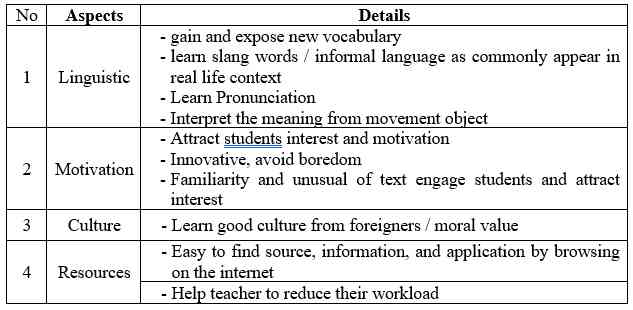The opportunities of using authentic materials are students can develop language skills such as listening, reading, vocabularies, and pronunciation. The authentic materials also can motivate students to actively engage in activities, learn good culture from foreigners, and easy to find the sources. Despite, teachers also face challenges which include the linguistic demands that will affect students' interest and motivation, inappropriate culture, and difficult to find suitable text for low learners and also time consuming.
Suggestions
For the English teachers who assigned to teach low proficiency learners, the researcher would like to suggest the teacher to use various kinds of authentic materials especially on the use of ICT or internet both as resource or medium because the school provided the infrastructure and students seems enthusiast when they use technology. Teachers can also let their students work collaboratively with their friends. This activity enables low learners to share their ideas, reduce anxiety, and motivate them to actively participate in activity. Moreover, teacher can use clear instructions so the time will not run out by repeated instruction. Regarding to cultural issue, besides looking for the text that suitable to students' local culture, teacher can develop students cross cultural understanding by comparing their own culture with others culture.
For the further research, deeply analysis on low proficiency students' perception after they use authentic materials is also necessary to develop the effectiveness of using authentic materials for lower-level learners especially in EFL context.
REFERENCES
- Adam, S.L., Stan, R.S., & Moanga, A.S. (2011). Authentic language teaching materials -- advantages and challenges. Bulletin UASVM Horticulture, 68(2), 353-356.
- Bahgban, Z. (2011). A review on the effectiveness of using authentic materials in ESP courses. English for Specific Purposes World, 31(10).
- Bahrani, T., & Tam, S.S. (2012). Audiovisual news, cartoons, and films as sources of authentic language input and language proficiency enhancement. TOJET: The Turkish Online Journal of Educational Technology, 11(4) Retrieved from http://search.proquest.com/docview/1288340600?accountid=62100
- Berardo, S.A. (2006). The use of authentic materials in the teaching of reading. The Reading Matrix, 6(2), 60-69.
- Burns, N., & Grove, S.K. (2003). Understanding nursing research. 3rd edition. Philadelphia: Saunders
- Erben, T., Ban, R., & Castaeda, M. (2009). Teaching English language learners through technology. New York: Routledge.
- Gilmore, A. (2007). Authentic materials and authenticity in foreign language learning. Language Teaching, 40(2), 97-118. Retrieved from http://search.proquest.com/docview/217740247?accountid=62100
- Guariento, W. & Morley, J. (2001). text and task authenticity in the EFL classroom. ELT Journal, 55(4), 47-353
- Hafiz, K. (2013). An investigation into CALL in English language teaching through language laboratory. IOSR Journal of Humanities and Socio Science (IOSR-JHHS), 6(6), 8-14.
- Kilickaya, F. (2004). Authentic materials and cultural content in EFL classrooms. The Internet TESL Journal, 10(7). Retrieved from http://iteslj.org/Techniques/Kilickaya-AutenticMaterial.html
- Kirana, D.P. (2014). Authentic materials in EFL classrooms. Cendekia, 12(2), 353-364.
- Mishan, F. (2005). Designing authenticity into language learning materials. Bristol: Intelect Books.
- Moleong, Lexy J. (2014). Metodologi Penelitian Kualitatif. Bandung: PT Remaja Rosdakarya.
- Nunan, D. (2004). Task based language teaching. Cambridge, UK: Cambridge University Press.
- Ozverir, I. and Herrington, J. (2011). Authentic activities in language learning: Bringing real world relevance to classroom activities. In: World Conference on Educational Multimedia, Hypermedia and Telecommunications (EDMEDIA), Lisbon, Portugal, 1423-1428.
- Polio, C. (2014). Using authentic materials in the beginning language classroom. Clear News, 18(1), 1-8.
- Richards, J.C. (2001). Curriculum development in language teaching. Cambridge: Cambridge University Press.
- Richards, J.C. (2006). Communicative language teaching today. Cambridge: Cambridge University Press.
- Tomlinson, B. (2005). Materials development in language teaching. Cambridge: Cambridge University Press.
About The Author
ENDAH SRI ELYAWATI, S.Pd is a teacher in SMP Islam Nabilah, Batam. Her interest includes Teaching English, material development, and ICT in Education.
Follow Instagram @kompasianacom juga Tiktok @kompasiana biar nggak ketinggalan event seru komunitas dan tips dapat cuan dari Kompasiana. Baca juga cerita inspiratif langsung dari smartphone kamu dengan bergabung di WhatsApp Channel Kompasiana di SINI









